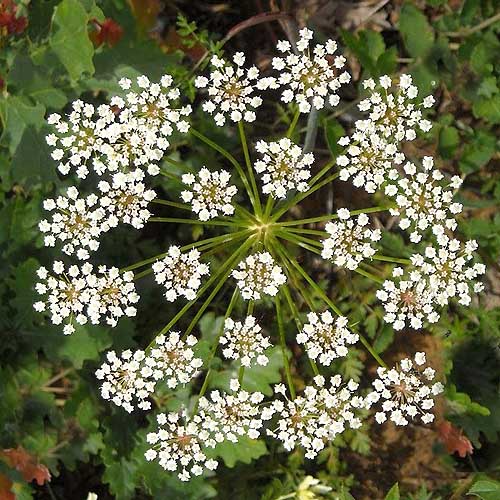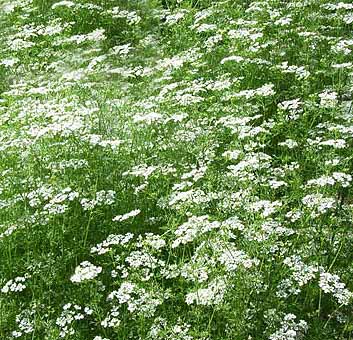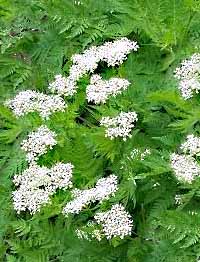Anise is a lovely airy feathery annual plant with large umbels of white flowers that appear to float in a sea of fluffy green. Planted in drifts they make a magnificent display. Anise has a long taproot and does not like to be transplanted but once in a sunny location with some shelter from the wind the elegant plant will bloom for over a month. Its not a fussy plant and takes little care and attention once established. The whole plant is aromatic and edible. However its aroma is also attractive to other animals especially deer to it will need protection.
Description of Anise (Pimpinella Anisum).
Anise is a beautiful dainty annual plant. It begins with a group of simple shallow
lobed leaves with toothed edges close to the ground these are usually 1 ½"
- 4" long ( 4-10cm). Once established the plant puts up tall grooved stalks
whose leaves, which are arranged alternately, are much more feathery and divided
into numerous leaflets. Stalks can reach 36" (1m) in height branching out
at about half that height with each stem topped by a wide umbel of small white
flowers. Each flower is only about 3mm in diameter but the whole flat umbel
can be as large as 6-7" across. Flowers bloom from the outside to center
of each sub umbel so flowering can last a considerable time. Flowers are followed
by oblong seeds up to 5mm long that are slightly flattened and slightly hairy.
The whole plant has a licorice type aroma.
Growing Anise (Pimpinella Anisum).from Seed.
Anise plants produce a taproot which does not like to be disturbed, so it does
not take well to transplanting. However anise also needs a longish growing period
to produce good seed so for those in cooler locations starting seeds indoors
should be considered. In all cases seeds seem to benefit from being soaked in
water overnight before planting.
Direct sowing.
Plant seeds when all danger of frost has passed. Dig over the soil where the
plants are to be located. Rake top soil until it is fine. If soil is extremely
poor add some organic material, but otherwise leave alone. Sow seeds about 1"
apart (2.5-15 cm) cover seeds with a shallow depth of soil. ½" is
ideal but no more than 1" (1-3 cm )or seeds will not be able to penetrate
to the surface. Keep seeds moist until they germinate. When they reach the two
leaf stage thin plants to 6-8" apart (15-20cm). If sowing in rows leave
at least 18-24" (45-60cm)between rows. Water daily and keep the area free
of weeds until the plants are well established.
Starting indoors.
Since anise has a taproot it is recommended that they plants be started in small
pots, 2-4 seeds to a pot. These can either be peat pots or small plastic ones.
Use a good fine seed starter mix. Seeds usually germinate in about 10 -12 days
at temperatures around 68°F (20°C). After germination keep seedlings
moist and allow to grow to small plants. Check for roots penetrating the pots,
or showing at the base of plastic pots. If roots are visible its time to transplant
the seedlings. Do not allow the roots to become too large outside the pots or
the plants will not transplant well. Ensure that plants are hardened off to
the outside before transplanting to desired location. See our general
growing instructions for more details.
When transplanting ensure that final location is well prepared. Dig holes the
size of the pots and place peat pots directly in the ground. If using small
plastic pots tap ensure that the soil is slightly dry before transplanting,
over wet soil does not come cleanly from a pot. Tap the pot smartly on the bottom
and the plant should come out in one whole piece. Carefully transplant this
to the ground without disturbing any roots.
Ensure plants are still small when transplanting. Leaving plants to get larger,
with anise, can often cause the plants to become stunted once transplanted since
they don't like their taproots moved. This can result in poor seed yield.
Location and Care of Anise (Pimpinella Anisum).
Anise is a fairly fragile plant and will be easily blown down in the wind so
a sheltered location in full sun is required in most cases. Anise likes some
heat but not really hot, so if you are growing in a zone below 7a some shade
may
be needed in the middle of the day to ensure the plants do not crisp in
the heat.
Anise is a bit more fussy than some plants about its soil, it needs one that
is well drained and does not do well in waterlogged soils. Sandy soils will
be tolerated as long as sufficient organic material has been added to ensure
a reasonable soil structure. It will grow well in a fairly wide pH range (5.0
- 8.0) although above 6.5 adding some lime to lessen the acidity is recommended.
Unless the soil is extremely poor anise does not need fertilizer it actually
does better on poorer soils.
While anise prefers regular watering it will do fairly well in semi dry soils. It does not really like the soil to be moist all the time. However in dry areas or in times of low rainfall additional water should be provided.
Anise is best grown in large groups. Its delicate stems and feathery nature make it a rather fragile plant which therefore does best in a crowd. It also looks far more dramatic if grown as an ornamental and can be extremely attractive if grown in drifts. Then the large white umbels appear to float on a sea of feathery foliage.
While anise has a strong aroma which in many plants causes wildlife to avoid them, anise seems to attract them, deer, bears rabbit mice and even dogs are attracted to the aroma, therefore some protection for your plants may be necessary.
Harvesting of Anise (Pimpinella Anisum).
Leaves. Can be removed as needed as soon a the plant is over 12" in height.
It is not recommended to harvest from smaller plants since anise is quite delicate,
it can stunt the growth or sometimes kill the plant. Once the plants begin to
flower leaves can easily be harvested. Use snips or scissors to remove leaves,
do not pull them off as this may inadvertently destroy the whole delicate plant.
Seeds. Once the umbels have developed full pump seeds cut the head off before
the seed falls. Spread on trays or a sheet in a sheltered area or indoor space
to dry then strip the seeds from the heads. Store seeds in airtight containers
in a warm, dry, dark, location. For seeds to be replanted store at cool temperature
to keep seed viable.
For culinary and medicinal uses, keep seeds whole until needed as the ground
spice quickly looses its aroma and flavour.
Anise Potential Plant Pests and Diseases
Unfortunately while anise is very popular to with butterflies, bees humming
bird moths and other beneficial insects its also a favorite of many pests. If
you love butterflies you may decide to accept the caterpillars of which really
like this plant. If your garden has been planted with a diversity of different
plants that bloom at different times and so attract beneficial insects these
many of these pests may not be a problem as these other insects will take care
of them for you. However at times they can become a problem.
These include several kinds of blight and rusts mostly caused by fungi. Powdery and downy mildew, armyworms, cutworms, aphids and root knot nematodes
Culinary Uses of Anise (Pimpinella Anisum).
Anise is used in a wide range of different dishes from savory to sweet. The
young leaves can be eaten cooked or raw. They have a refreshing sweet aniseed
flavor and can be added to salads or just chewed alone. Both leaves and seeds
can be added to soups, stews, sausages and other meat products. Leaves or seeds
can be added to vegetables such as potatoes, sweet potatoes, turnips or other
root vegetables or rice to give a more interesting flavour. It also works well
with eggs, cheese and spinach and is often used in omelet's and pasta. Anise
is also used to flavour cakes, cookies, candy, ice cream, chewing gum, pickles
and a multitude of other culinary treats. The seeds can also be used to make
a
refreshing tea.
Aniseed is the basis for flavouring may popular liqueurs from many different countries. These include France: Absinthe, Anisette, Ricard and Pastis; Greek: Ouzo, Italian: Sambuca, Anesone, German: Jägermeister, Spanish: Ojen, Eastern European: Mastika, Turkish: Raki, Egyptian: Kibib, Arab: Arrak, Peruvian: Anís, as well as Virgil's root beer in the United States.
Medical uses of Anise (Pimpinella Anisum).
Aniseed has long been used to help in many maladies. Most commonly it is used
to help the digestive system and is excellent for helping indigestion and gas
as well as bloating, colic and nausea. It is also used to treat asthma, whooping
cough, bronchitis, coughs especially wheezing ones, fevers, toothache, menstrual
cramps, colds and loss of appetite. It has also be shown to stimulate lactation
and act as a mild diuretic. It is very mild and well suited for treatment in
both children and elderly patients. Externally it can be used to treat infestations
of lice, scabies and as a chest rub in cases of bronchial disorders. Brewed
as a tea and soaked in a warm cloth it can be applied as compress to eye pain
relief or to swollen or aching breast, especially during periods of lactation.
Seeds are antiviral and antibiotic so chewing the seeds helps freshen the breath
and kill bacteria.
Other uses of Anise (Pimpinella Anisum).
Animals like the smell of Anise too.
Many animals are attracted to the smell of anise. This is most commonly in the
form of the essential oil, not the plant. This has long been known to be attractive
to dogs and is often an ingredient in dog food. It is often used to it is also
used as the scent on the artificial rabbit in greyhound races and to lay trails
for hunting and by anti-blood sport movements to put hounds off the scent.
Other animals also like anise. Deer find it particularly attractive and it is often an ingredient in hunting lures. Bears also find it attractive as well as rats and mice. For this reason it is often used to bait rodent traps as the animals find it irresistible. Even fish like it and putting it on fishing lures is said to attract many more fish.
But not all of them.
Slugs and snails hate it, planting anise near slug attracting plants can often
deter them, or using a spray containing anise can often keep the creatures away.
A spray made from a tea of anise and coriander is supposedly very effective
against spider mites and woolly aphids. Anise is poisonous to pigeons.
Other names.
aniseed








